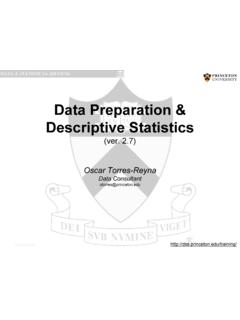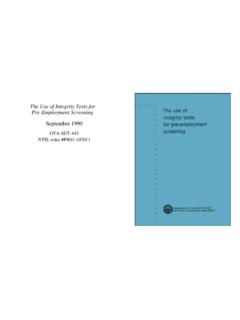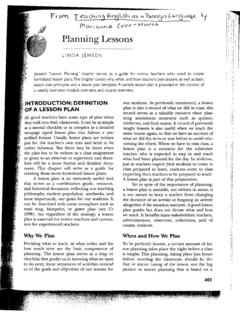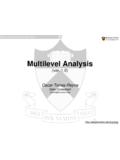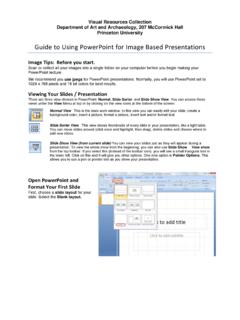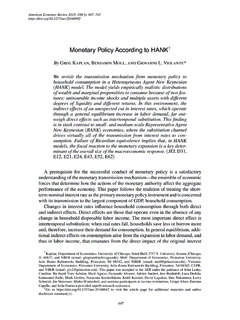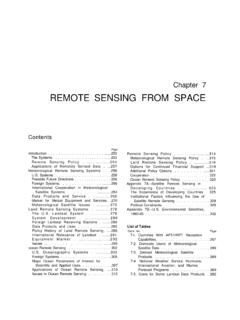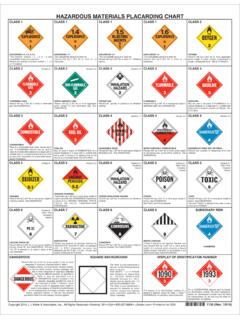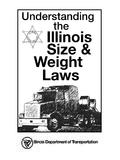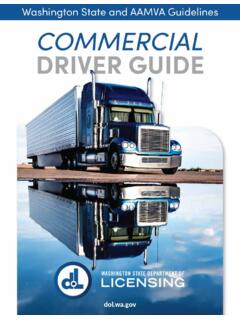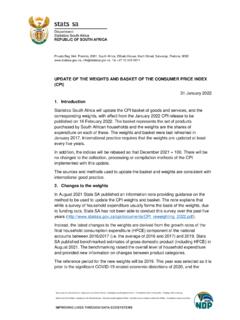Transcription of Using stargazer to report regression output and ...
1 Using stargazer to report regression output and descriptive statistics in R (for non-LaTeX users) ( draft) Oscar Torres-Reyna May 2014 Introduction As anything with R, there are many ways of exporting output into nice tables (but mostly for LaTeX users). Some packages are: apsrtable, xtable, texreg, memisc, outreg ..and counting. At the moment, the new kid on the block is stargazer . Released by Marek Hlavac on March 3rd, 2014, version offers a very nice, smart, and easy-to-use alternative to non-LaTeX users, in particular, the ability to import editable tables into a Word document. This presentation will show some of the options stargazer offers, the contents are based on the documentation from the package available in the following links: The default setting produces LaTeX code, the additional alternatives are: output as text, which allows a quick view of results output as html, which produce editable tables for Word documents.
2 2 OTR output IN TEXT FORMAT For a quick view of the results use the text format option 3 OTR Descriptive statistics: in text format mydata <- mtcars (" stargazer ") #Use this to install it, do this only once library( stargazer ) stargazer (mydata, type = "text", title="Descriptive statistics", digits=1, out=" ") OTR Descriptive statistics ======================================== ====================== Statistic mpg cyl disp hp drat wt qsec vs am gear carb N 32 32 32 32 32 32 32 32 32 32 32 Mean St. Dev. Min 4 52 0 0 3 1 Max 8 335 1 1 5 8 ---------------------------------------- ---------------------- Descriptive statistics ====================================== Statistic N Mean St.
3 Dev. Min Max mpg 32 cyl 32 4 8 disp 32 hp 32 52 335 drat 32 wt 32 qsec 32 vs 32 0 1 am 32 0 1 gear 32 3 5 carb 32 1 8 -------------------------------------- The table will be saved in the working directory with whatever name you write in the out option. You can open this file with any word processor # Same output , transposed (variables in columns) stargazer (mydata, type = "text", title="Descriptive statistics", digits=1, out=" ", flip=TRUE) Use this option if you want the variables in columns For more details/options type ?
4 stargazer stargazer will automatically recognize the type of object, and will produce the appropriate output . In the case of data frames, it will display summary statistics . 4 Descriptive statistics: in text format, replacing variable names with labels mydata <- mtcars (" stargazer ") #Use this to install it, do this only once library( stargazer ) stargazer (mydata, type = "text", title="Descriptive statistics", digits=1, out=" ", ("Miles/(US)gallon","No. of cylinders","Displacement ( )", " gross horsepower","Rear axle ratio"," weight (lb/1000)", "1/4 mile time","V/S","Transmission (0=auto, 1=manual)", "Number of forward gears","Number of carburetors")) OTR The table will be saved in the working directory with whatever name you write in the out option.
5 You can open this file with any word processor Descriptive statistics ======================================== ==================== Statistic N Mean St. Dev. Min Max Miles/(US)gallon 32 No. of cylinders 32 4 8 Displacement ( ) 32 gross horsepower 32 52 335 Rear axle ratio 32 weight (lb/1000) 32 1/4 mile time 32 V/S 32 0 1 Transmission (0=auto, 1=manual) 32 0 1 Number of forward gears 32 3 5 Number of carburetors 32 1 8 ---------------------------------------- -------------------- Use the option to replace variable names with variable labels.
6 Must be in same order as in the dataset. For more details/options type ? stargazer 5 Descriptive statistics: in text format, selected variables mydata <- mtcars (" stargazer ") #Use this to install it, do this only once library( stargazer ) stargazer (mydata[c("mpg","hp","drat")], type = "text", title="Descriptive statistics/selected variables", digits=1, out=" ") OTR #same output transposed and with labels instead of variable names stargazer (mydata[c("mpg","hp","drat")], type = "text", title="Descriptive statistics/selected variables", digits=1, out=" ", flip=TRUE, ("Miles/(US)gallon"," gross horsepower","Rear axle ratio"))
7 Descriptive statistics/selected variables ======================================== =================== Statistic Miles/(US)gallon gross horsepower Rear axle ratio N 32 32 32 Mean St. Dev. Min 52 Max 335 ---------------------------------------- ------------------- Descriptive statistics/selected variables ===================================== Statistic N Mean St. Dev. Min Max mpg 32 hp 32 52 335 drat 32 ------------------------------------- The table will be saved in the working directory with whatever name you write in the out option.
8 You can open this file with any word processor Use this option if you want the variables in columns Use the option to replace variable names with variable labels. Must be in same order as in the dataset. For more details/options type ? stargazer 6 Descriptive statistics: in text format, selected variables, and by group mydata <- mtcars (" stargazer ") #Use this to install it, do this only once library( stargazer ) # Descriptive statistics for cars with automatic transmission stargazer (subset(mydata[c("mpg","hp","dr at")], mydata$am==0), title="Automatic transmission", type = "text", digits=1, out=" ") OTR # Descriptive statistics for cars with manual transmission stargazer (subset(mydata[c("mpg","hp","dr at")], mydata$am==1), title="Manual transmission", type = "text", digits=1, out=" ") Manual transmission ===================================== Statistic N Mean St.
9 Dev. Min Max mpg 13 hp 13 52 335 drat 13 ------------------------------------- Automatic transmission ===================================== Statistic N Mean St. Dev. Min Max mpg 19 hp 19 62 245 drat 19 ------------------------------------- The table will be saved in the working directory with whatever name you write in the out option. You can open this file with any word processor For more details/options type ? stargazer Use subset() to select the category Use subset() to select the category 7 regression models: in text format mydata$fast <- ((mydata$mpg > )) #Creating a dummy variable 1 = fast car m1 <- lm(mpg ~ hp, data=mydata) m2 <- lm(mpg ~ hp + drat, data=mydata) m3 <- lm(mpg ~ hp + drat + factor(gear), data=mydata) m4 <- glm(fast ~ hp + drat + am, family=binomial(link="logit"), data=mydata) stargazer (m1, m2, m3, m4, type="text", ("Miles/(US) gallon","Fast car (=1)"), (" gross horsepower","Rear axle ratio","Four foward gears", "Five forward gears","Type of transmission (manual=1)"), out=" ")
10 OTR The table will be saved in the working directory with whatever name you write in the out option. You can open this file with any word processor For the predictors, you have the option to use variable labels instead of variable names (in order they appear) For more details/options type ? stargazer For the output , you have the option to use variable labels instead of variable names (according to the type of model) 8 output IN HTML FORMAT For a nice presentation use the html option, open it with any word processor 9 OTR regression models: in html format mydata$fast <- ((mydata$mpg > )) #Creating a dummy variable 1 = fast car m1 <- lm(mpg ~ hp, data=mydata) m2 <- lm(mpg ~ hp + drat, data=mydata) m3 <- lm(mpg ~ hp + drat + factor(gear), data=mydata) m4 <- glm(fast ~ hp + drat + am, family=binomial(link="logit"), data=mydata) stargazer (m1, m2, m3, m4, type="html", ("Miles/(US) gallon","Fast car (=1)"), (" gross horsepower","Rear axle ratio","Four foward gears", "Five forward gears","Type of transmission (manual=1)"), out=" ")
